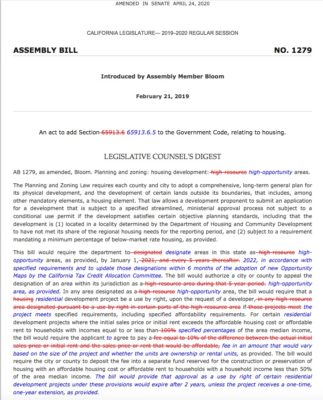Local lawmaker pushes for denser housing: Assemblyman Bloom has two bills
Following the defeat of SB 50, and its predecessor SB 827 — controversial bills that would have preempted local control of zoning — California politicians have returned to the drawing board.
Among them, local Assemblyman Richard Bloom, who has a constituency that stretches from Santa Monica to Larchmont Village, has sponsored two housing-related bills that deserve your attention.
AB 1279
This bill by Bloom, which passed the Assembly in May 2019 and now sits in the Senate Housing Committee, would direct the state’s Department of Housing and Community Development (HCD) to designate “high-opportunity areas,” which are not yet defined, to promote denser development. According to law firm Holland & Knight partner Jennifer Hernandez, these areas are expected to overlap at least in part with federal Economic Opportunity Zone tax relief areas.
In short, the bill allows for a CEQA-exempt (California Environmental Quality Act) housing approval process for residential development projects meeting size and other eligibility criteria.
What do supporters say about the bill?
San Francisco-based civil rights law firm Public Advocates described their support of the bill in an April 2020 update: “To promote more mixed-income and affordable housing development in areas with wealth and other resources where low-income people have been denied an opportunity to live for generations.” The Western Center on Law & Poverty, another co-sponsor of the bill, says of the legislation: It “would facilitate denser, mixed income and affordable housing development in high-resource communities that lack racial and economic diversity.”
The devil might be in the details, critics argue.
What is an opportunity zone? What does it mean to lack racial and economic diversity? These are questions that can be sorted out after the legislation is passed, supporters say.
“Not so fast,” argues the California State Association of Counties (CSAC) in a letter to Sacramento: “Our organizations have a general policy concern with the bill’s delegation of legislative prerogative to the executive branch to develop definitions that will dictate where AB 1279 will apply. We strongly prefer to develop a specific definition in statute.”
The advocacy group Livable California argues that AB 1279 would jam ultra-dense housing into newly defined areas: “Bloom would force 50-unit and 120-unit apartments into fully settled, stable communities. Which ones? AB 1279 will map them out later, then drop the mess on we, the public.”
Bloom, unavailable
In an attempt to find some clarity as to what constitutes a “high-opportunity area,” the Chronicle made multiple requests over a three-week period to chat with Bloom about the legislation that he authored. According to Chief of Staff Guy Strahl, Bloom’s schedule could not accommodate a phone call during that time because lawmakers were working to catch up on the legislative calendar after an extended recess due to the coronavirus.
AB 3173
Introduced by Bloom in Feb. 2020, this bill would require cities with more than 400,000 people to permit the development of “micro-unit buildings” that include units that are no greater than 80 square feet, excluding a bathroom. Local agencies may establish a minimum size for a micro-unit less than 80 square feet. Affordable units are not required in the bill.
Sure, building closet-size apartments does produce density, but who does it serve?
The idea that a couple, much less a family with kids, could live in such a small space is hard for some critics to imagine. However, the benefit to developers is clear: Micro-units can double the rent per square foot of a midsize apartment. In an Urban Land Institute study, “The Macro View on Micro Units,” the think-tank found that: “In the West, price premiums for small units reach 43 percent over their mid-sized counterparts and a whopping 80 percent over the large units.”
Senate housing production package
Our local lawmaker, Bloom, authored the two bills discussed above, but they are in no way the only housing bills currently being considered in Sacramento. In fact, the California Senate Democrats released a Housing Production Package of five bills on May 20 that, if passed, would modify existing CEQA requirements in an attempt to increase and expedite housing production.
Those bills include: SB 902 (Wiener), SB 995 (Atkins), SB 1085 (Skinner), SB 1120 (Atkins) and SB 1385 (Caballero).
“This is light touch density, but it has the possibility to significantly increase housing over time,” said state Sen. Scott Wiener about SB 902, which he filed after his efforts to pass both SB 50 and SB 827 failed.
Category: Real Estate


how will it be guarenteed to go to low income? it won’t and with Covid density doesn’t sound good